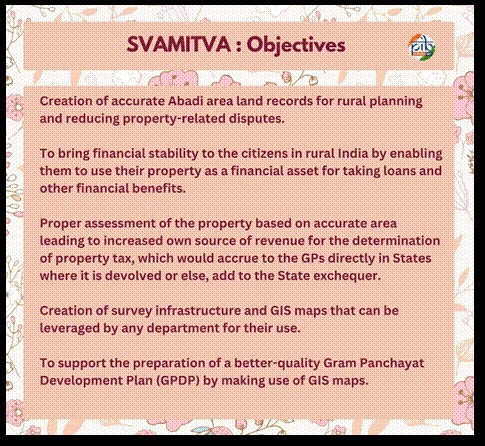-
02 Apr 2025
GS Paper 2
Geography & Economy
Day 27: How does the SVAMITVA Scheme contribute to providing an integrated and transparent property validation framework in rural India? (38 marks)
Approach:
- Give a brief introduction to the SVAMITVA Scheme.
- Elaborate the aim of the scheme in integrating rural India.
- Conclude accordingly.
Introduction:
Property ownership in rural India has long remained informal and undocumented, often leading to disputes, underutilization of land, and exclusion from formal credit systems. The SVAMITVA Scheme, launched by the Ministry of Panchayati Raj in 2020, provides an integrated and transparent property validation solution using modern technology, thereby transforming rural governance and land ownership.
Body:
- Use of Technology for Accurate Land Mapping: The scheme employs drone-based surveys and CORS (Continuously Operating Reference Stations) to map inhabited rural land parcels.
- It ensures high-resolution, geo-referenced mapping, leading to precise identification and demarcation of properties.
- At the national level, 92% of the notified villages under the scheme have achieved drone survey completion (January 2025).
- Issuance of Legal Ownership Records: The key output is the provision of 'Property Cards', which serve as official ownership documents.
- These cards legally empower rural landholders, allowing them to use their property as financial assets.
- Integration with Digital Governance Platforms: SVAMITVA data is integrated with eGramSwaraj and property tax systems for better planning and revenue collection.
- It enables Panchayati Raj Institutions to access up-to-date spatial and ownership data for local development.
- Reduction in Land Disputes and Legal Clarity: The drone-based mapping minimizes overlapping claims and brings clarity to ownership boundaries, reducing litigation.
- Transparent digital records promote dispute-free inheritance, transfers, and leasing of rural property.
- Boost to Rural Credit Access and Financial Inclusion: With legal ownership proof, rural citizens can avail bank loans and mortgages against their property.
- This promotes financial inclusion and unlocks the economic potential of rural landholders.
- Promotion of Self-Reliance and Grassroots Empowerment: The scheme enhances citizen confidence and dignity, especially among women and marginalized groups.
- In many states, joint ownership of property cards is encouraged to ensure gender equity.
- Pilot Success and National Roll-Out: Initially launched in six states, the scheme was extended nationwide in April 2021.
- Around 2.25 crore property cards have been issued under the scheme as of January 2025.
- Convergence with Panchayati Raj Reforms: SVAMITVA strengthens Gram Panchayats by improving property tax collection and enabling evidence-based spatial planning.
- It supports the vision of Atmanirbhar Bharat by enhancing transparency, accountability, and local governance.
- Environmental and Disaster-Resilience Benefits:
- The digital mapping data can aid in disaster management, climate-resilient planning, and infrastructure development.
Conclusion:
The SVAMITVA Scheme marks a paradigm shift in rural land governance, bringing legal clarity, digital empowerment, and economic opportunity to India’s rural landscape. By integrating technology with legal validation and governance, it lays the foundation for inclusive and transparent rural development, aligning with the goals of Digital India and Atmanirbhar Bharat.





